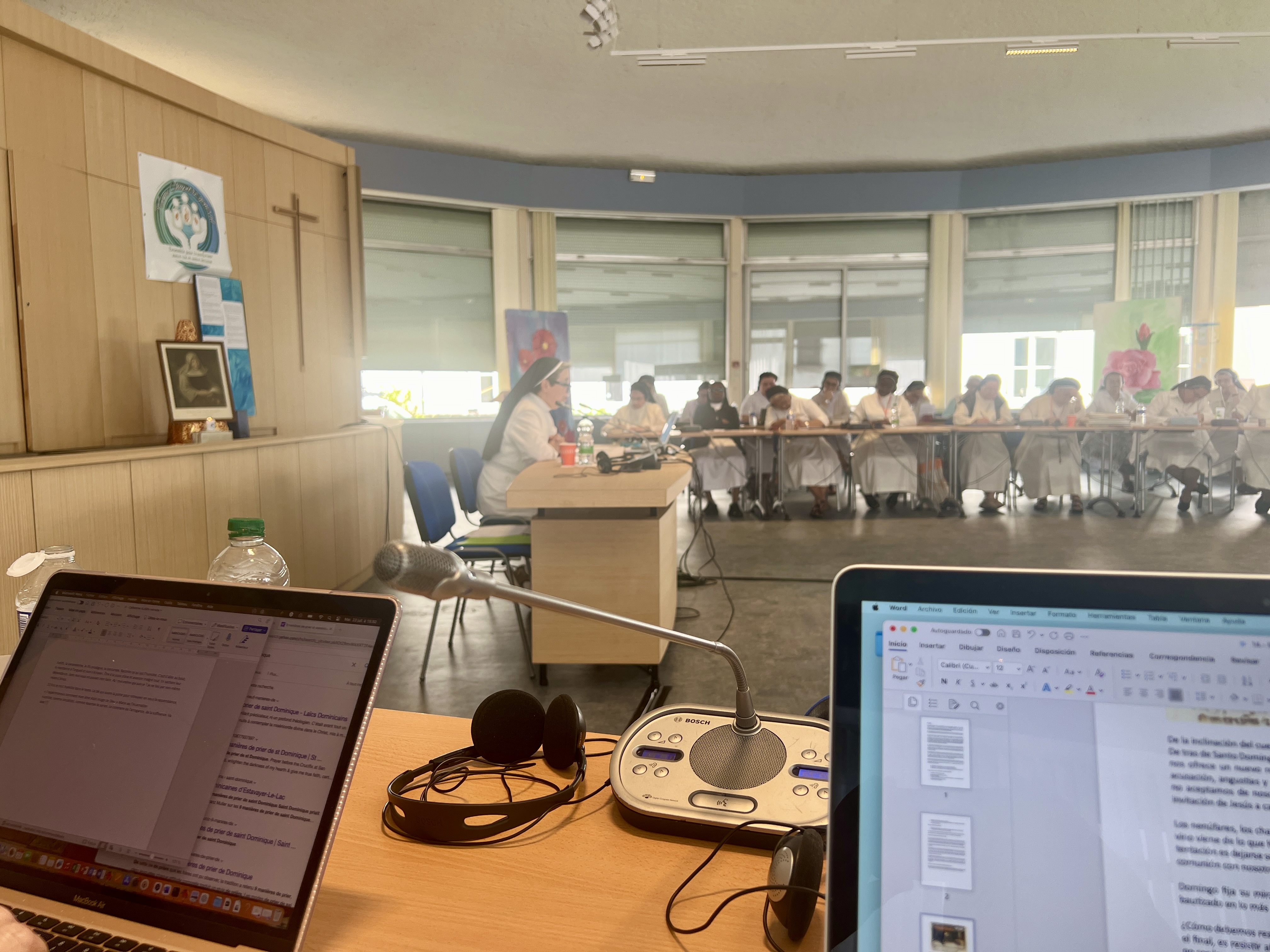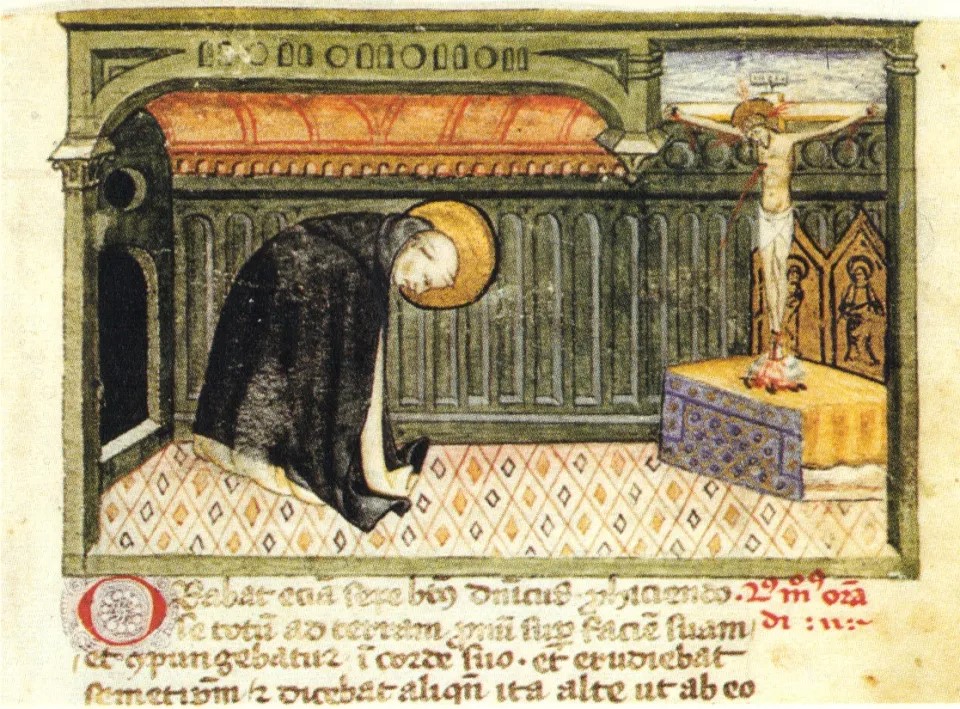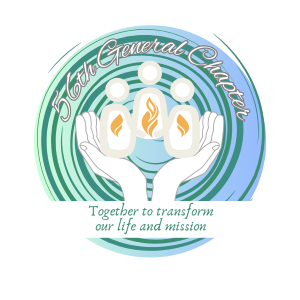In Retreat
- by Dominicas
-
in News
-
Hits: 426

La Grande Bretèche (Tours), 23/07/2024, Sor Gemma Morató i Sendra y Sor Conchi García Fernández - www.domipresen.com.- Sister Catherine Aubin, whom we introduced yesterday, began her sermon by saying that in the midst of a chapter, having a retreat is telling the Lord: You are the Master of time.
During these days, we will be accompanied by the nine ways of praying of Saint Dominic, which are a true pedagogy of interiority; it will be to pray and love with the saint of Caleruega.
Sister Catherine assures that Dominic was famous for his prayer and not for his preaching, although the friars might not like this statement. The testimonies of his canonization, when asked about his prayer, highlight that he prays at night; that he speaks aloud, which was common at that time, with an extremely lively dialogue; that he cries, a typical aspect of the Desert Fathers, showing his heart, as we are bound by Him who loves us; that he shouts, "What will become of sinners?"; and lastly, that Dominic ruminates all the time.
From all these observations, the nine ways of praying of Saint Dominic are born, remembering that he left nothing written. The first five ways are a pedagogy to learn to pray; it is not a matter of learning gestures, but of entering within oneself, into our heart. The sixth and seventh ways narrate a miracle; and the eighth and ninth remind us that Dominic is like a prophet.
We delve into the Bible with the question "Where are you?" It is a provocation, for if we are asked, it means we are lost. We revisit the acedia from last night's presentation. Have we lost the taste of God? Where are we? If we try to respond, we are on the move; if it is routine, be careful because we can fall into this invisible, discreet, and silent acedia, which is unseen and destroys everything.
Lord, make me know you and know myself. It is to know myself with God. God seeks us, calls us with that "Where are you?" (Gen 3:9-10). Our God is a God of attention, care, and mercy. Dominic understood this question. And the way of praying is a response to this question:
- I have heard your voice, I welcome you as you welcome me (ways 1-5).
- I have heard your voice, and I let you visit and find me (ways 6 and 7).
- I have heard your voice, and here I am to be with you, for You and others (ways 8 and 9).
Each bodily action corresponds to a spiritual attitude:
- 1) The Inclination: humility of the heart.
- 2) Prostration: compunction of the heart.
- 3) Discipline: docility.
- 4) The Genuflexion: trust in God's mercy, for him, all his brothers, and the whole world.
- 5) The Elevation: listening that raises us.
- 6) Crossed: a way of praying that represents the resurrection.
- 7) Hands Raised: in a place of charity and visited by the Holy Spirit. He wishes to live according to the Spirit.
- 8) The Kiss: argues with the Lord based on the Word, it is the way of doing lectio divina.
- 9) Working: leaves to share what he has contemplated.
The challenge of spiritual life is to accept reality. We must return to ourselves and to God. We are far from ourselves; we are not where we should vibrate, in our hearts, we are in the mind. It is a path of truth, knowledge, and interiority. Let us not stay only in images. What matters is Christ and the Spirit that animates. Let us go to what the heart manifests.
The body shows the intensity of the relationship with God. Tell me how you pray, and I will tell you who your God is. In the nine ways, each way of praying is in a different cell, each with a living Christ, with open eyes, the blood of Christ manifests salvation.
This cell is open to us, and Dominic invites us to enter the cell of his heart. They are like icons, to enter them. We are invited to enter the secret of Dominic's heart.
Finally, we must understand different ways, from visible to invisible, entering the pardes (paradise), with four levels: the literal level, what we understand or see without questions: a door; the level of evocation, what it can mean: "take the door"; interpretation, the door is the place that separates two spaces; and finally, mystery and revelation: I am the door, someone knocks at the door... We must listen and understand beyond what is said and seen.
We must enter the place of rest, of the Sabbath; for the Jews, God withdrew for man to exist, and now we withdraw to make room for the One who speaks to us.
First way of praying: from the bowing of the body to the humility of the heart

Dominic humbles himself before the altar. Behind Saint Dominic, an open, dark door is the womb that brings us into the world, offering us a new beginning. It is the door from where we come, doubts, shame, accusation, anguish, and fears... it indicates a path of change if we accept what we do not accept about ourselves or our past. We must change our posture; it is Jesus' invitation to change direction, even if it is only a millimeter.
Water lilies, mushrooms, and penicillin come from what is rotten, good wine comes from what has fermented. And our good will come from our poverty. The temptation is to be seduced by power, knowledge... Dominic teaches us to commune with ourselves. He fixes his gaze on Christ and sees his humility. Jesus is humility; he was baptized in the lowest place, the Jordan, which is far below sea level.
How should we pray? With attention in the heart, humbly. Humility is to go to the end, to resist pride. It is to advance despite everything and find what is already there, not to be what we are not. It is simplicity, the key that opens the door, the sweetness that goes with consolation.
Saint Francis de Sales said that to enter prayer, one must do as Simeon, take Jesus his hands.


